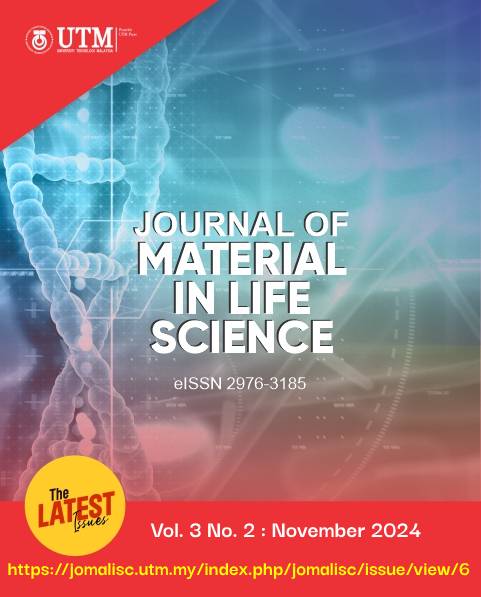Green Synthesis of Magnesium Oxide Nanoparticles using Asystasia gangetica and its Antibacterial Study Against Gram-Positive and Gram-Negative Bacteria
Keywords:
MgO-NPs, green synthesis, nanoparticles, antibacterial activityAbstract
Magnesium oxide nanoparticles (MgO-NPs) have various potential in medicine, catalysis and electronics due to their tailored properties on side and shape. it is important to obtain MgO-NPs by using green synthesis approach through the utilization of various parts of plants, such as the aloe vera plant, rambutan seeds, and clove flower, in synthesizing MgO-NPs. In this study, MgO-NPs are produced using Asystasia gangetica plant extract via the green combustion method. Characterization involves Thermal Gravimetric Analysis (TGA), Fourier Transform Infrared Spectroscopy (FTIR), X-ray Diffraction (XRD), Scanning Electron Microscopy (SEM), UV-Vis Spectroscopy (UV-Vis), and Accelerated Surface Area and Porosimetry (ASAP). TGA results reveal that MgO achieves its stability around 650 °C, leading to the determination of the calcination temperatures at 700 °C and 800 °C. FTIR analysis reveals Mg-O stretching (670 cm-1 to 700 cm-1). XRD and SEM show high crystalline MgO-NPs with particle sizes of about 149 - 298 nm. ASAP indicates mesoporous characteristics with plate-like pores. Antibacterial activities were evaluated through a well diffusion method using Gram-positive (Staphylococcus aureus) and Gram-negative (Escherichia coli) bacteria. Antibacterial activity against Staphylococcus aureus is significant at concentrations of 500 mg/mL for MgO-NPs calcined at 800 °C, while no significant activity is observed against Escherichia coli. The promising results of green synthesis have high potential for further study.
References
Ansari, A., Ali, A., Asif, M., & Shamsuzzaman, M. (2017). Microwave-assisted MgO NP catalyzed one-pot multicomponent synthesis of polysubstituted steroidal pyridines. New Journal of Chemistry, 42(1), 184–197. https://doi.org/10.1039/C7NJ03742B
Ashok, K. S., Jarvin, M., Sharma, S., Umar, A., Inbanathan, S. S. R., & Nayak, A. K. (2021). Facile and green synthesis of MgO nanoparticles for the degradation of Victoria Blue dye under UV irradiation and their antibacterial activity. ES Food and Agroforestry, 5, 14–19. https://doi.org/10.30919/ESFAF519
Baig, N., Kammakakam, I., Falath, W., & Kammakakam, I. (2021). Nanomaterials: A review of synthesis methods, properties, recent progress, and challenges. Materials Advances, 2(6), 1821–1871. https://doi.org/10.1039/D0MA00807A
Saidi, N. S. M., Ying, K. J., Yusoff, H. M., & Badar, N. (2023). Synthesis and characterization of magnesium oxide nanoparticles by using banana peel (Musa Acuminata Cavendish) extract. Malaysian Journal of Analytical Sciences, 27(5), 1017–1034.
Saidi, N. S. M., Badar, N., Yusoff, H. M., & Elong, K. (2024). Effect of Zn, Ti, and Sn dopants on the structural, morphological, and optical properties of MgO nanoparticles synthesized via green combustion using Persicaria odorata leaves extract. Emergent Materials. https://doi.org/10.1007/s42247-024-00871-2
Farizan, A. F., Yusoff, H. M., Badar, N., Bhat, I. U. H., Anwar, S. J., Wai, C. P., Asari, A., Kasim, M. F., & Elong, K. (2022). Green synthesis of magnesium oxide nanoparticles using Mariposa christia vespertilionis leaves extract and its antimicrobial study toward S. aureus and E. coli. Arabian Journal for Science and Engineering, 48(6), 7373–7386. https://doi.org/10.1007/S13369-022-07282-7
Yusoff, H. M., Rafit, F. A., Mohamad, F. I., Hassan, N., & Daud, A. I. (2017). The effects of calcination temperatures in the synthesis of nanocrystalline magnesium oxide via sol-gel technique. Applied Mechanics and Materials, 865, 36–42. https://doi.org/10.4028/WWW.SCIENTIFIC.NET/AMM.865.36
Idris, N. A., Aziz, N. A. A., Yusoff, H. M., Badar, N., Elong, K., Yusoff, F., Wai, C. P., & Hassan, N. (2023). Electrochemical performance of zinc oxide nanoparticles prepared via green synthesis route using Chromolaena odorata leaves extract as potential anode material in sodium-ion battery. Journal of Sustainability Science and Management, 18(10), 126–137. http://doi.org/10.46754/jssm.2023.10.008
Balouiri, M., Sadiki, M., & Ibnsouda, S. K. (2016). Methods for in vitro evaluating antimicrobial activity: A review. Journal of Pharmaceutical Analysis, 6(2), 71. https://doi.org/10.1016/J.JPHA.2015.11.005
Rotti, R. B., Sunitha, D. V., Manjunath, R., Roy, A., Mayegowda, S. B., Gnanaprakash, A. P., Alghamdi, S., Almehmadi, M., Abdulaziz, O., Allahyani, M., Aljuaid, A., Alsaiari, A. A., Ashgar, S. S., Babalghith, A. O., Abd El-Lateef, A. E., & Khidir, E. B. (2023). Green synthesis of MgO nanoparticles and its antibacterial properties. Frontiers in Chemistry, 11. https://doi.org/10.3389/FCHEM.2023.1143614
Mugabo, P., & Raji, I. A. (2013). Effects of aqueous leaf extract of Asystasia gangetica on the blood pressure and heart rate in male spontaneously hypertensive Wistar rats. BMC Complementary and Alternative Medicine, 13, 283. https://doi.org/10.1186/1472-6882-13-283
Pradita, T., Shih, S. J., Aji, B. B., & Sudibyo. (2017). Synthesis of MgO powder from magnesium nitrate using spray pyrolysis. AIP Conference Proceedings, 1823. https://doi.org/10.1063/1.4978089
Khdary, N. H., Seddiq, W. K., Alkurdi, M. E., Alyamani, E. J., ALangari, A. A., & Aly-amani, E. J. (2019). Enhance the antimicrobial activity of silver nanoparticles by manipulating a redox process and controlling the size of the particles. Biomedical Journal of Scientific & Technical Research, 16(4), 1–9. https://doi.org/10.26717/BJSTR.2019.15.002882
Thill, A. (2016). Characterisation of imogolite by microscopic and spectroscopic methods. Developments in Clay Science, 7, 223–253. https://doi.org/10.1016/B978-0-08-100293-3.00010-8
Mamatha, K. M., Srinivasa Murthy, V., Ravikumar, C. R., Murthy, H. C. A., Kumar, V. G. D., Kumar, A. N., & Jahagirdar, A. A. (2022). Facile green synthesis of molybdenum oxide nanoparticles using Centella Asiatica plant: Its photocatalytic and electrochemical lead sensor applications. Sensors International, 3, 100153. https://doi.org/10.1016/J.SINTL.2021.100153
Zhang, L., Wu, P., Chen, H., Yuan, L., Yang, G., Xie, H., Liang, D., Xie, J., Deng, L., & Al, -. (2019). Effect of calcination temperature on visible near-infrared reflectance of aluminum-doped chromium. https://doi.org/10.1016/j.mssp.2019.104672
Chan, Y. B., Selvanathan, V., Tey, L. H., Akhtaruzzaman, M., Anur, F. H., Djearamane, S., Watanabe, A., & Aminuzzaman, M. (2022). Effect of calcination temperature on structural, morphological, and optical properties of copper oxide nanostructures derived from Garcinia mangostana L. leaf extract. Nanomaterials, 12(20). https://doi.org/10.3390/NANO12203589
Koroth, S. K., Saji, A., Chanda, A., & Vasundhara, M. (2022). Effects of calcination temperatures on structural, optical, and magnetic properties of MgO nanoflakes and its photocatalytic applications. Optical Materials, 132. https://doi.org/10.1016/J.OPTMAT.2022.112777
Thommes, M., Kaneko, K., Neimark, A. V., Olivier, J. P., Rodriguez-Reinoso, F., Rouquerol, J., & Sing, K. S. W. (2015). Physisorption of gases, with special reference to the evaluation of surface area and pore size distribution (IUPAC Technical Report). Pure and Applied Chemistry, 87(9–10), 1051–1069. https://doi.org/10.1515/PAC-2014-1117
Huang, L., Yang, Z., & Wang, S. (2020). Influence of calcination temperature on the structure and hydration of MgO. Construction and Building Materials, 262, 120776. https://doi.org/10.1016/J.CONBUILDMAT.2020.120776
Kauffmann, A. C., & Castro, V. S. (2023). Phenolic compounds in bacterial inactivation: A perspective from Brazil. Antibiotics, 12(4). https://doi.org/10.3390/ANTIBIOTICS12040645
Kuo, Y.-C., Lin, S.-P., Lin, C.-W., Tsai, Y.-C., Wu, T.-S., & Hsiao, I.-L. (2023). Enhanced antibacterial activity in cellulose acetate films with surface defect-rich MgO nanoparticles for sustainable active packaging applications. ACS Applied Nano Materials, 6(21), 19915–19925. https://doi.org/10.1021/ACSANM.3C03724
Basir, O. H., Zaid, N. A., Mohd Fauzi, N. A., & Razak, A. H. (2020). Characterization of Asystasia gangetica and Phyllanthus niruri extracts: Total phenolic content, antioxidant and antibacterial activities. Journal of Sustainable Nature Resources. https://doi.org/10.30880/jsunr.2020.01.02.006


















